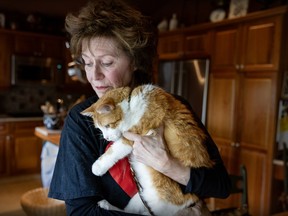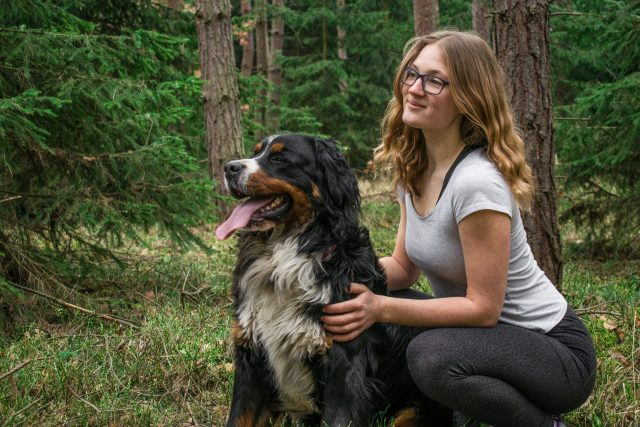Cats are abandoned for many reasons, including the refusal of many landlords to accept pets. Now, a program that helps “community cats” is in jeopardy.
Article content
Doc, as Diane Liebling named him — because she names every cat she traps or finds or otherwise helps as chair of the Côte-St-Luc Cats Committee — was found by a resident who then contacted Liebling. Doc was a purebred Scottish Fold, about 16 years old, and he’d likely been abandoned.
“I tried everything to find his owner because I was having a hard time believing somebody would abandon an old, sick cat,” she recalled.
Advertisement 2
Article content
“Well, believe it.”
Unable to locate his owner, she placed Doc with one of her fosters. It was June 2022. He died that September of end-stage kidney failure.
A retired nurse with the kindest eyes, Liebling is the heart and soul of the Côte-St-Luc Cats Committee, an all-volunteer initiative that has been operating in the west-end municipality for about 15 years. It was established to trap unowned cats often referred to as feral (she prefers to call them community cats), have them sterilized by a veterinarian and returned to the same place they were found. Cats are territorial and studies have shown that simply their presence prevents other — possibly unsterilized — cats from moving in to fill the void.
Neutering — one ear is tipped or notched in a universal sign — is a bid to stabilize the out-of-control overpopulation of these cats. A single unspayed female producing two litters a year can be responsible for more than 11.6 million cats in less than a decade, according to the committee. It’s estimated that 480 million of the world’s 700 million cats are feral.
Under the auspices of the Côte-St-Luc committee’s Trap Neuter Return Maintain program, neutered cats are fed by volunteers at a few locations around the neighbourhood — food is paid for through committee funds — or by volunteers in their own yards.
Advertisement 3
Article content
The cats know where to go.
Starting in September, winter shelters are distributed in partnership with Educhat, a not-for-profit organization also operating a Trap Neuter Return Maintain program. The shelters are free to Côte-St-Luc residents; others pay $35.
But that’s not the half of it. The committee’s mandate has expanded to deal with lost cats and kittens or cats who were abandoned. Liebling spends hours some days trapping cats and less time other days — but, emotionally, she is involved all the time.
“I am constantly emailing people in the middle of the night,” she said. “There is a huge psychological component every day to what I do. I don’t know anyone who does this work who isn’t sad or affected in some way. A few have had to stop. Burnout and compassion fatigue take a tremendous toll on many rescuers.”
Cats are abandoned for different reasons, from the rising cost of veterinary care and food to the refusal of many landlords to rent to companion animal owners, said Liebling, 71.
“If you have to move and can’t find a place that accepts animals, what are you supposed to do? A lack of affordable housing … is a really big issue.”
Article content
Advertisement 4
Article content
If a Côte-St-Luc resident contacts her about an abandoned or lost cat or one who has been spotted under a balcony with a litter, “I am happy to help and will trap a cat and have it neutered or spayed,” she said. “But I need a commitment from you, if the cat is not adoptable, to feed the cat.”
If the cat is sociable, Liebling looks for a foster home or permanent home and has arranged dozens of adoptions. A home visit for potential adopters is mandatory, she said, and one reason is to ensure the cat’s safety — to make sure, among other things, the cat won’t be let out onto a balcony.
“Every year, cats die from jumping off balconies,” she said.
If someone from another neighbourhood gets in touch, “I try to help where I can, with advice or by lending out a trap,” said Liebling, but she won’t trap.
Côte-St-Luc is the only municipality within Montreal with a dedicated program for community cats. SPCA Montreal operates a Trap Neuter Return Maintain program for residents of most, but not all, city neighbourhoods.
Although dozens of Trap Neuter Return Maintain programs may exist throughout Quebec, most operate without funding from any level of government and rely on volunteers, community donations and “a song and a prayer,” as Liebling put it.
Advertisement 5
Article content
In areas not covered by such programs, “there is a never-ending cycle of stray, abandoned and feral cats,” said Michael Cohen, Côte-St-Luc’s city councillor responsible for animal protection. “The suffering of these animals is appalling.”
If Liebling, who got her first cat at age five, is this concerned about their welfare, it’s because she loves them. “My passion, my care, my concern: I want that to come through.”
She and her husband, Allen Mendel, share their home with several cats — all rescues. Most were abandoned. The most sociable is 12-year-old Emerson, who joined the family when he was about a year old.

“He was found on the street not far from me, and he was a sweetheart from Day One,” Liebling said. “He is the only one of my cats that is instantly OK with everyone. The others mostly keep their distance.”
For 14 years, the committee received an annual grant of just over $5,000 from the city, unchanged despite significant increases in the cost of food and veterinary services. Even with discounted rates, the committee’s quarterly vet bills are generally $3,000 to $5,000. Raffles, garage and bake sales and tax-deductible donations bring in additional funds.
Advertisement 6
Article content
Last year, city council increased the committee’s stipend to $10,500. But because significant cuts were needed to arrive at a balanced budget, the contribution was dropped back to $5,000. Combined with a shrinking surplus fund, the committee’s future was in jeopardy.
An awareness campaign this month brought in generous donations, including one of $2,500 and another of $2,000, “and that will take us to the end of the year, but we need a lot more,” said Cohen, who established the cat committee with former Côte-St-Luc resident Shelley Schecter, the head of Educhat.
“We still don’t have enough money to do what we want to do and the program is at risk beyond next year,” he said. “We need someone to say, ‘I am going to give you $10,000 per year perpetually’ or the program won’t be able to continue.”
Liebling’s garage holds up to seven large cages for cats recuperating from procedures, particularly females who have been spayed. Neutering surgery for males is less extensive, so recovery time is shorter.
A dozen or so volunteers “do the heavy lifting” for the committee and a couple of dozen feed the community cats and help out occasionally, Cohen said.
Advertisement 7
Article content
“But it is all anchored by Diane. Without her, we wouldn’t be able to sustain the program. How many people would do this year-round? She rescues cats, gets cats fostered and adopted, gets funding organized. She is doing the job of five people.”

Côte-St-Luc’s public security department contacts Liebling about abandoned cats or to let her know if a resident who was feeding community cats has been admitted to a hospital.
She does most of the trapping, with assistance from a few committee members. The main reason she’ll trap a cat is because she thinks it hasn’t been neutered.
“If somebody advises me of a cat in their backyard, I ask them to feed consistently and on a schedule to get the cat used to coming to them,” she said. “If the cat stays in the area and I think needs to be trapped, I will go ahead and trap the cat. But if the cat has a collar and tag and looks healthy, I assume he belongs to somebody and I will not trap unless there’s a compelling reason.”
A Côte-St-Luc bylaw allows for owned cats to roam free, as long as they wear a collar and tag. Liebling doesn’t agree with the bylaw.
Advertisement 8
Article content
“Too many cats go outside, never to return,” she said, becoming victims of predators or poison or motor vehicles.
If a microchipped cat turns up in Côte-St-Luc, she can generally have its owner found, such as a downtown cat who turned up at the library feeding station.
“A cat can get into the back of a truck and end up anywhere,” she said.
“If I find a cat that is not microchipped, but friendly, I will do everything I can to find the owner, especially if the cat has been neutered,” Liebling said. She might post on Facebook sites for lost cats and SPCA Montreal’s Found Cats page.
A stray cat was probably once a companion animal and can usually be resocialized and adopted, whereas a community, or feral, cat has had little or no contact with humans. They can be socialized, but Liebling questions whether it’s the best use of a community’s resources.
“I tell people: ‘If cats are unsocialized and they go back outside and someone is going to feed them and shelter them for the rest of their lives, accept it.'”
In Côte-St-Luc, community cats who get sick are trapped and taken to a vet and, once treated, returned to the place where they were picked up.
“It’s nice that a cat can be looked after,” Liebling said. “I feel like the cats in Côte-St-Luc get really good care.”
AT A GLANCE
Contact Diane Liebling at 514-236-2099 or dianeliebling@gmail.com. Donations to the Côte-St-Luc Cats Committee can be sent via e-transfer to CSLcats@cotesaintluc.org.
sschwartz@postmedia.com
Recommended from Editorial
Advertisement 9
Article content
Article content





